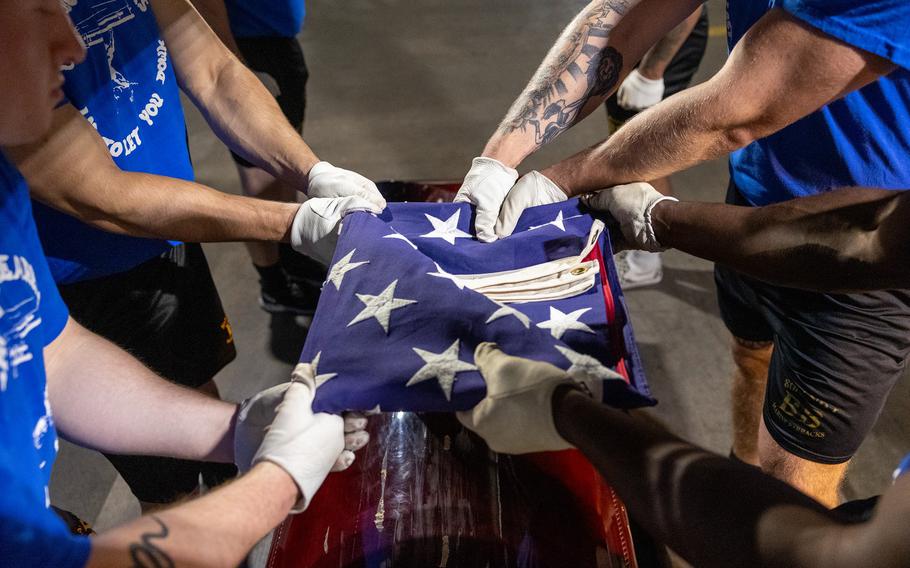
The Marine Body Bearer section practices folding the American flag at Marine Barracks Washington on Friday, June 13, 2025. (Eric Kayne/Stars and Stripes)
WASHINGTON — With silent precision and unwavering discipline, the Marine Corps Body Bearers reflect 250 years of Marine Corps ethos.
“Everything the Marine Corps stands for is being the best, no matter what it takes,” said Cpl. Kent Place, of Niantic, Conn., who has been a part of the Body Bearers section for a year and a half. “We continue to uphold our high standards regardless of changes that are being made because that’s what the families deserve.”
As “The last to let you down” — the sacred motto — the hand-selected section of 12 Marines renders final honors to Marines, Marine veterans and their immediate family members at Arlington National Cemetery, Va., and across the national capital region.
“At any time a Marine has fallen and has a funeral at Arlington National Cemetery ... we’re there to perform a flawless funeral every single time,” Place said.
A spokesperson for Marine Barracks Washington said the section is not typically assigned to support funerals out of state. All funeral requests come through Arlington National Cemetery, which coordinates services with the funeral director at the Marine Barracks.
In January, the section transported President Jimmy Carter to his funeral service at the National Cathedral in Washington, to his lying in state in the Capitol Rotunda and then his final resting place in Plains, Ga. In November 2023, the Body Bearers supported the former first lady Rosalynn Carter’s funeral, also in Plains.
The section is based at Marine Barracks Washington, which is also home to the Marine Corps Silent Drill Platoon, “The Commandant’s Own” United States Marine Drum and Bugle Corps, “The President’s Own” United States Marine Band and the official Marine Corps Color Guard.
‘Laying them to rest with honor’
The Body Bearers practice funeral sequences in an underground parking garage at the Marine Barracks to preserve the sanctity of their solemn duty. They practice carrying different sizes and weights of caskets at shoulder length, and practice folding the American flag, performing the sequence as they would at a ceremony.
They are the only Body Bearer section in the military to carry the casket at shoulder length. Additionally, the section carries a casket with six Body Bearers compared to the eight that other services use. Before lowering a casket for burial, Marine Body Bearers raise the casket to eye level to symbolize a final salute.
“Being able to honor them one last time and laying them to rest with honor is super important,” said Cpl. Jacob Dorton, of Orem, Utah, a member of the Body Bearer section.
Marine Body Bearers are expected to meet strict strength requirements, including 10 repetitions of: a bench press of 225 pounds, military press of 135 pounds, curls of 115 pounds and squats of 315 pounds. They are also required to consistently achieve first-class test scores in physical fitness and combat fitness.
“There is absolutely zero option to let go of that urn or drop that casket,” Place said. “And that reflects down on our training. We completely push our bodies to the very limit. We break our mental barriers and push even further past that.”
“It’s that family’s worst day. ... No matter what I’m feeling, how tired or thirsty or hungry I am, I need to put out for that family and make sure that I’m paying attention to the details and doing the sequence the way it’s supposed to be performed.””
— Cpl. Jacob Dorton
Becoming a Marine Body Bearer is highly competitive. Prospects must be between 70-76 inches tall, hold the rank of sergeant or below and be able to serve 30 months following the check-in at ceremonial drill school, which is located at the Marine Barracks. Those chosen undergo up to a year of intensive training before being deemed ready to carry out ceremonial duties.
While in ceremonial drill school, Marines carry out the ceremonial duties of Body Bearers but must continue their self-paced educational requirements to earn the formal title of Marine Corps Body Bearer.
“For those who have the opportunity to become a Body Bearer, remember your training and always seek the next level of perfection,” Place said.
‘Emotionally and mentally taxing’
The Marine Body Bearers average 400 funerals a year, according to a spokesperson for the Marine Barracks. In addition to the strength required to carry caskets, Marine Body Bearers are also expected to be emotionally strong.
“This job is definitely emotionally and mentally taxing because we’re still human beings at the end of the day,” Place said. “And 200, 300, 400 funerals later, that burden that we carry just gets heavier.”
Dorton said his first funeral was an urn burial of a Marine’s dependent. He said he was “super nervous” conducting the sequence by himself and facing grieving loved ones, but he kept his composure and remembered his training. He has carried out 325 funerals during his two years in the section.
“It’s that family’s worst day. It’s the one funeral they’re going to get,” Dorton said. “No matter what I’m feeling, how tired or thirsty or hungry I am, I need to put out for that family and make sure that I’m paying attention to the details and doing the sequence the way it’s supposed to be performed.”
‘Like a brotherhood’
Only a small percentage of Marines are selected to become Body Bearers. Place said that having fellow Marines who understand the challenges and responsibilities is “like a brotherhood and is super special.”
“You are tied to the Body Bearer community,” Place said. “Former Body Bearers from all sorts of different generations all check up on each other. There’s always someone who’s there before you that’s going to check up on you. And there’s future generations of Body Bearers to come that will come after us, and it’ll be our time to look over them.”